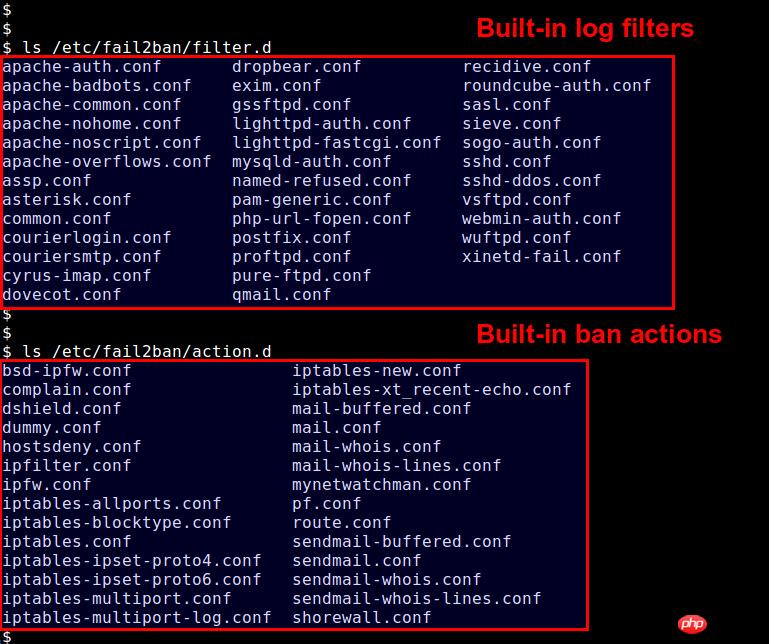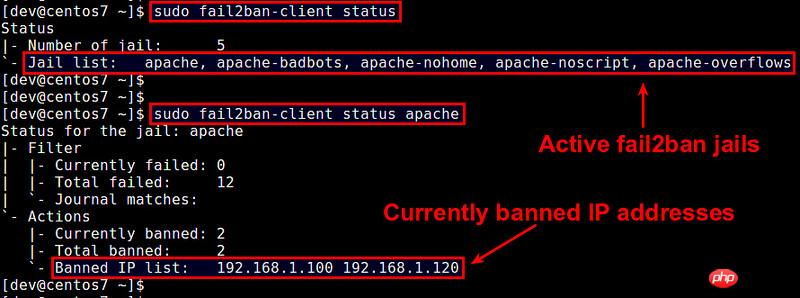 Operation and Maintenance
Operation and Maintenance
 Linux Operation and Maintenance
Linux Operation and Maintenance
 Teach you how to configure fail2ban to protect the Apache server
Teach you how to configure fail2ban to protect the Apache server
Teach you how to configure fail2ban to protect the Apache server
Jun 27, 2017 am 09:51 AMThis article mainly introduces the method of configuring fail2ban to protect the Apache server, mainly to filter IP addresses. The example is based on the Linux system. Friends in need can refer to it
In production environment The Apache server may be vulnerable to different attacks. An attacker may attempt to gain access to unauthorized or prohibited directories through brute force attacks or the execution of malicious scripts. Some malicious crawlers may scan your website for various security vulnerabilities, or send spam by collecting email addresses and web forms.
The Apache server has a comprehensive log function that can capture abnormal events reflected in various attacks. However, it is not yet able to systematically parse specific apache logs and quickly react to potential attacks (eg, ban/unban IP addresses). At this time, fail2ban can save all this and free up the system administrator's work.
fail2ban is an intrusion prevention tool that can detect different tools based on system logs and automatically take protective measures, such as banning IPs through iptables, blocking connections through /etc/hosts.deny, or sending notifications through email . fail2ban has a series of predefined "jails" that use specific program log filters to detect common attacks. You can also write custom rules to detect attacks from arbitrary programs.
In this tutorial, I will demonstrate how to configure fail2ban to protect your apache server. I assume you already have apache and fail2ban installed.
What is Fail2ban Jail
Let’s take a deeper look at fail2ban jail. Jail defines specific application policies, which trigger a protection measure for a specified program. fail2ban has predefined jails under /etc/fail2ban/jail.conf for some popular programs such as Apache, Dovecot, Lighttpd, MySQL, Postfix, SSH, etc. Each jail detects common attacks through specific program log filters (under /etc/fail2ban/filter.d). Let me look at an example jail: SSH jail.
The code is as follows:
[ssh]
enabled = true
port = ssh
filter = sshd
logpath = /var/log/auth.log
maxretry = 6
banaction = iptables-multiportThe configuration of the SSH prison defines these parameters:
[ssh]: The square brackets are the prison's name.
enabled: whether to enable the jail
port: port number (or corresponding service name)
filter: log parsing rules for detecting attacks
logpath: detected log file
maxretry: maximum failure Number of times
banaction: The banned operations
Any parameters defined in the jail configuration will override the corresponding default configuration parameters in fail2ban-wide. Instead, any missing parameters use the default value defined in the [DEFAULT] field.
Predefined log filters are placed in /etc/fail2ban/filter.d, and the prohibited actions that can be taken are placed in /etc/fail2ban/action.d.

If you want to override fail2ban's default behavior or define any custom jails, you can create /etc/fail2ban/jail.local* files. In this tutorial, I will use /etc/fail2ban/jail.local.
Enable predefined apache jails
The default installation of fail2ban provides some predefined jails and filters for the Apache service. I want to enable these built-in Apache jails. Since Debian and RedHat are configured slightly differently, I will provide their configuration files separately.
Enabling Apache jail on Debian or Ubuntu
To enable the predefined apache jail on Debian-based systems, create /etc/fail2ban/jail.local as follows.
$ sudo vi /etc/fail2ban/jail.local
The code is as follows:
# 检测密码认证失败
[apache]
enabled = true
port = http,https
filter = apache-auth
logpath = /var/log/apache*/*error.log
maxretry = 6
# 检测漏洞和 PHP 脆弱性扫描
[apache-noscript]
enabled = true
port = http,https
filter = apache-noscript
logpath = /var/log/apache*/*error.log
maxretry = 6
# 检测 Apache 溢出攻击
[apache-overflows]
enabled = true
port = http,https
filter = apache-overflows
logpath = /var/log/apache*/*error.log
maxretry = 2
# 检测在服务器寻找主目录的尝试
[apache-nohome]
enabled = true
port = http,https
filter = apache-nohome
logpath = /var/log/apache*/*error.log
maxretry = 2Since the above jails do not specify measures, these jails will trigger default measures. To see the default action, find "banaction" under [DEFAULT] in /etc/fail2ban/jail.conf.
The code is as follows:
banaction = iptables-multiport
In this example, the default operation is iptables-multiport (defined in /etc/fail2ban/action.d/iptables-multiport.conf). This measure uses iptable's multiport module to ban an IP address.
After enabling the jail, you must restart fail2ban to load the jail.
$ sudo service fail2ban restart
Enabling Apache jails in CentOS/RHEL or Fedora
To enable predefined jails in Red Hat-based systems, create /etc/fail2ban/ as follows jail.local.
$ sudo vi /etc/fail2ban/jail.local
The code is as follows:
# 检测密码认证失败
[apache]
enabled = true
port = http,https
filter = apache-auth
logpath = /var/log/httpd/*error_log
maxretry = 6
# 检测抓取邮件地址的爬虫
[apache-badbots]
enabled = true
port = http,https
filter = apache-badbots
logpath = /var/log/httpd/*access_log
bantime = 172800
maxretry = 1
# 检测漏洞和 PHP 脆弱性扫描
[apache-noscript]
enabled = true
port = http,https
filter = apache-noscript
logpath = /var/log/httpd/*error_log
maxretry = 6
# 检测 Apache 溢出攻击
[apache-overflows]
enabled = true
port = http,https
filter = apache-overflows
logpath = /var/log/httpd/*error_log
maxretry = 2
# 检测在服务器寻找主目录的尝试
[apache-nohome]
enabled = true
port = http,https
filter = apache-nohome
logpath = /var/log/httpd/*error_log
maxretry = 2
# 检测执行不存在的脚本的企图
# 这些都是流行的网站服务程序
# 如:webmail, phpMyAdmin,WordPress
port = http,https
filter = apache-botsearch
logpath = /var/log/httpd/*error_log
maxretry = 2Note that the default operation of these jail files is iptables-multiport (defined in "banaction" under the [DEFAULT] field in /etc/fail2ban/jail.conf ). This measure uses iptable's multiport module to ban an IP address.
After enabling the jail, you must restart fail2ban to load the jail.
In Fedora or CentOS/RHEL 7:
$ sudo systemctl restart fail2ban
In CentOS/RHEL 6:
$ sudo service fail2ban restart
Check and manage fail2ban ban status
Once the jail is activated, you can use the fail2ban client command line tool to monitor the current ban status.
View the list of active jails:
$ sudo fail2ban-client status
View the status of a specific jail (including a list of banned IPs):
$ sudo fail2ban-client status [监狱名]

你也可以手动禁止或者解禁IP地址:
要用制定监狱禁止IP:
$ sudo fail2ban-client set [name-of-jail] banip [ip-address]
要解禁指定监狱屏蔽的IP:
$ sudo fail2ban-client set [name-of-jail] unbanip [ip-address]
总结
本篇教程解释了fail2ban监狱如何工作以及如何使用内置的监狱来保护Apache服务器。依赖于你的环境以及要保护的web服务器类型,你或许要调整已有的监狱或者编写自定义监狱和日志过滤器。查看outfail2ban的官方Github页面来获取最新的监狱和过滤器示例。
The above is the detailed content of Teach you how to configure fail2ban to protect the Apache server. For more information, please follow other related articles on the PHP Chinese website!

Hot Article

Hot tools Tags

Hot Article

Hot Article Tags

Notepad++7.3.1
Easy-to-use and free code editor

SublimeText3 Chinese version
Chinese version, very easy to use

Zend Studio 13.0.1
Powerful PHP integrated development environment

Dreamweaver CS6
Visual web development tools

SublimeText3 Mac version
God-level code editing software (SublimeText3)

Hot Topics
 PHP Framework Performance Comparison: The Ultimate Showdown of Speed vs. Efficiency
Apr 30, 2024 pm 12:27 PM
PHP Framework Performance Comparison: The Ultimate Showdown of Speed vs. Efficiency
Apr 30, 2024 pm 12:27 PM
PHP Framework Performance Comparison: The Ultimate Showdown of Speed vs. Efficiency
 The evasive module protects your website from application layer DOS attacks
Apr 30, 2024 pm 05:34 PM
The evasive module protects your website from application layer DOS attacks
Apr 30, 2024 pm 05:34 PM
The evasive module protects your website from application layer DOS attacks
 How to conduct concurrency testing and debugging in Java concurrent programming?
May 09, 2024 am 09:33 AM
How to conduct concurrency testing and debugging in Java concurrent programming?
May 09, 2024 am 09:33 AM
How to conduct concurrency testing and debugging in Java concurrent programming?
 Integration and expansion of golang function concurrency control and third-party libraries
Apr 25, 2024 am 09:27 AM
Integration and expansion of golang function concurrency control and third-party libraries
Apr 25, 2024 am 09:27 AM
Integration and expansion of golang function concurrency control and third-party libraries
 Application of algorithms in the construction of 58 portrait platform
May 09, 2024 am 09:01 AM
Application of algorithms in the construction of 58 portrait platform
May 09, 2024 am 09:01 AM
Application of algorithms in the construction of 58 portrait platform









